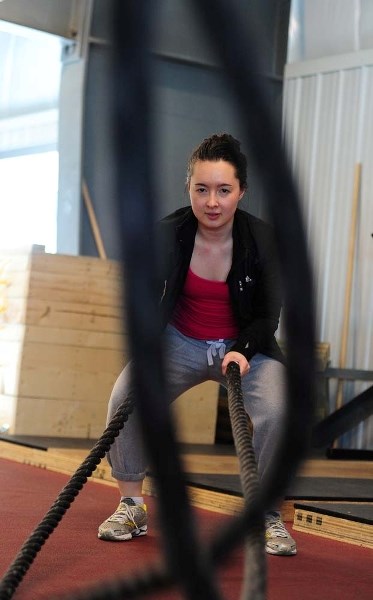Gazette reporter Amy Crofts will try a different workout each month in an attempt to inspire people to start their fitness new year’s resolutions early, rather than just in January. If you have a workout idea, email: [email protected]
The workout: grab the ends of a rope – which is anchored to a weightlifting apparatus – and swing it. Can’t be that hard, right?
The first 20 seconds go by in a flash as I wildly thrash the ropes through the air. I grin. This is actually quite fun.
Then after a 10 second break I start working on technique, trying to maintain the frequency of the undulations I create. I can feel my biceps working.
But as the intervals drag on, the rope gets heavier and heavier in my hands. At one point, an end flies out of my grip during some overzealous swinging. Man … this is hard.
Heavy ropes, also known as battle ropes or thick ropes, is an exercise that involves whipping a 30 to 50 foot long rope that is connected to an anchor point.
The routine is popular among athletes who require explosive power in sports such as hockey, football and MMA, says Peter Ramtuhul, exercise and wellness specialist at Servus Credit Union Place.
It is typically incorporated into high intensity interval training regimens. The idea is that you swing the ropes as hard as you can for as long as you can, usually in intervals of 20 to 30 seconds, interspersed with short breaks.
It’s not an exercise you can do for a full hour because of its intensity, says Ramtuhul. Ropes are good for building up strength – especially for the upper body, from forearms to shoulders – as well as cardiovascular conditioning.
My heart rate was already peaking after the first minute of “battling” the ropes.
To make the ropes a full body workout, they’re modified by incorporating jumping jacks, squats and planks. Rumtuhul shows me the “grappler throw” whereby you pivot your torso from side to side while flipping the rope as if you were throwing it to the floor.
I also tried alternating waves and the double wave (while holding both ends of the rope in one hand).
The “slam” – lifting both ends of the rope above your head then slapping them hard to the ground – was the modification that most engaged my full body, and the most satisfying to do.
Rumtuhul says working with the ropes results in low impact on the joints and minimal soreness.
“You don’t want soreness, you want to be able to train as often as possible. Something like ropes is great because you can use it at a high frequency.”
Despite its growing popularity, little research has been done into the metabolic costs and effectiveness of rope training.
A study published last year in the Journal of Strength & Conditioning concluded that a 10-minute bout of rope work – 10 repetitions of 15 seconds of double arm waves, followed by 45 seconds of rest – resulted in high heart rates and energy expenditure, meeting parameters known to increase cardio-respiratory fitness.
Rumtuhul says he uses the ropes at the end of the Tuesday interval circuit class he teaches at Servus. They require minimal supervision and people often don’t use it much in their own training.
“The thing I like about it is that it’s fun, it’s different and it’s very safe,” he says.
“People want to have fun when they work out. They don’t just always want to hop on the bike or go for a run. They want to do things that challenge them in different ways.”




